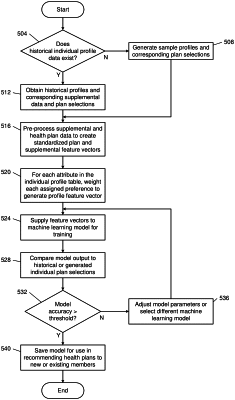| CPC G06Q 30/0282 (2013.01) [G06F 16/24578 (2019.01); G06N 20/00 (2019.01); G06Q 30/0203 (2013.01); G06Q 30/0205 (2013.01)] | 18 Claims |

|
1. A computer-implemented method comprising:
determining whether historical profile data structures are stored in a database with corresponding structured supplemental data and selected health care plan option identifiers of a set of health care plan option identifiers;
in response to a determination that historical profile data structures are stored in the database with corresponding structured supplemental data and selected health care plan option identifiers, generating historical feature vectors using the historical profile data structures and corresponding structured supplemental data and selected health care plan option identifiers stored in the database, and further using historical structured data corresponding to at least the selected health care plan option identifiers;
in response to a determination that historical profile data structures are not stored in the database with corresponding structured supplemental data and selected health care plan option identifiers, generating historical feature vectors using created sample profile data structures and corresponding sample structured supplemental data and sample selected health care plan option identifiers, and further using historical structured data corresponding to at least the sample selected health care plan option identifiers;
training, by one or more processors, multiple machine learning models using the generated historical feature vectors, wherein at least one of the multiple machine learning models is a different type of machine learning model than another one of the multiple machine learning models;
selecting one of the trained multiple machine learning models for use in generating recommendation outputs, wherein the selecting includes identifying a trained machine learning model having a highest output accuracy from among the trained machine learning models;
presenting, by the one or more processors, an interactive voice interface to an entity to generate audio questions and prompts based on an automatically generated survey for obtaining response data from the entity;
classifying, by the one or more processors, voice survey responses of the entity using natural language processing;
generating, by the one or more processors, feature vectors based on the classified voice survey responses of the entity;
processing, by the one or more processors and using the selected machine learning model, the feature vectors to generate the recommendation outputs, wherein the recommendation outputs includes at least one health care option identifier; and
transforming, by the one or more processors, a user interface to display the recommendation output to the entity.
|